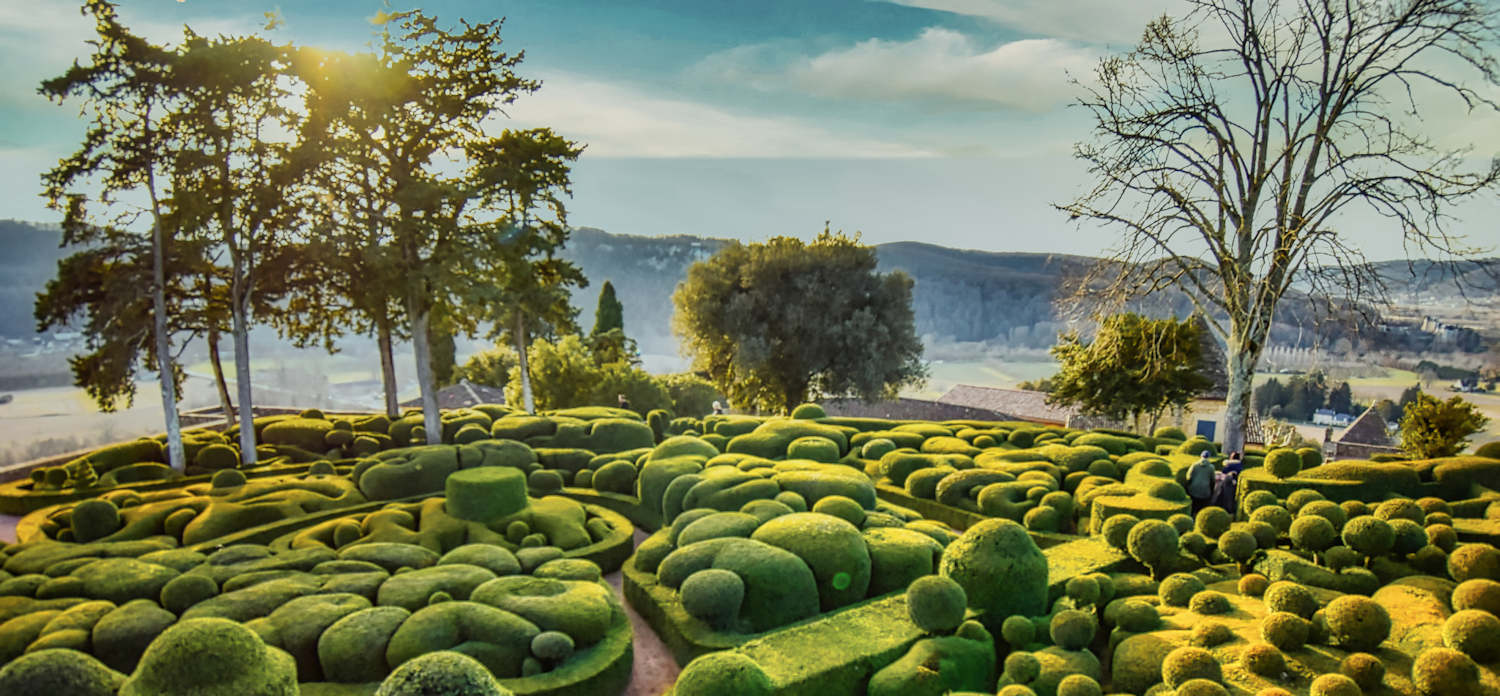
Perched on a promontory overlooking the Dordogne Valley, the Gardens of Marqueyssac form a singular sight which lends itself to multiple strolls. This photo reportage by Ava Kabouchy and Gary Lee Kraut explores the mood, botany, quirks, activities and enchantment of Marqueyssac through eight remarkable strolls.
Soon after moving to Dordogne in early 2023, Ava Kabouchy found herself intrigued by the Gardens of Marqueyssac, first as a visitor in awe of the clifftop estate, then as a photographer wishing to capture the impressive array of topiaries, the subtle shades of green, the long alleys, the wandering peacocks, the chapel beyond the iris bush, the gardeners at precision work, the employees informing and entertaining visitors, and more. From February through April, then again in December, she returned four more times to examine the abundant and eye-pleasing life of the 54-acre park with its more than 3½ miles of pathways.
I, Gary, also had the pleasure of strolling along the paths of Marqueyssac this year, on a bright September morning, and though writing is my primary tool rather than photography, I couldn’t help but want to record with my phone the views that I took in.
This photo reportage leans on Ava’s photographs, supported by my contributions and several photos provided by Marqueyssac itself. I organized the images into the eight strolls and wrote the descriptions and captions.
Where is Marqueyssac?
Located five miles from the well-preserved old town of Sarlat, Marqueyssac occupies a promontory 425 feet over the Dordogne River. Even without its gardens, Marqueyssac would be a worthy destination for its panoramic views out to the villages, chateaux, walnut orchards and winding river that make this such an alluring region. Add the gardens themselves—along with a small chateau, a café overlooking the valley, and numerous activities proposed to visitors—and you get a singular sight. While especially famous for its more than 150,000 boxwoods, Marqueyssac’s attraction extends well beyond them. The site lends itself to a variety of strolls: romantic, contemplative, family, boxwood-botanical, and more. Though the organized activities here slow down during the short cold days of late autumn and winter, Marqueyssac, open every day of the year, is truly a year-round destination.
The Boxwood or Botanical Stroll
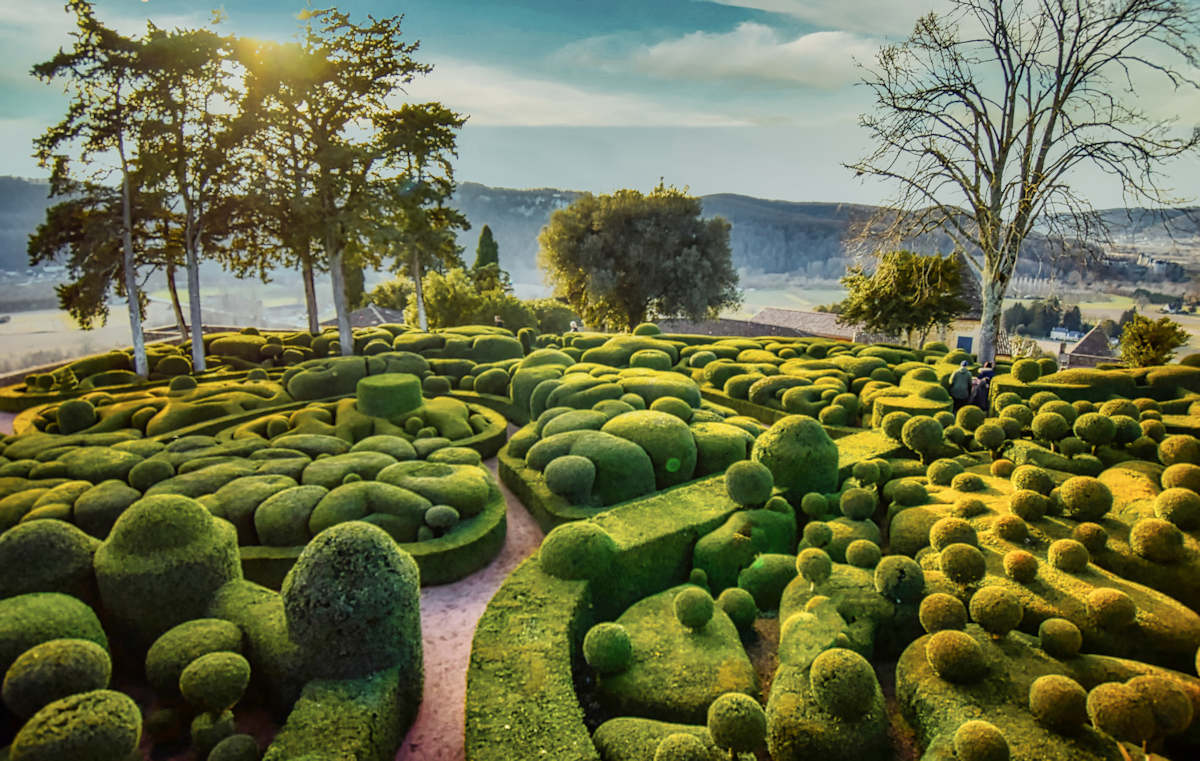
European boxwoods are the defining greenery of Marqueyssac. There are some 150,000 in all, either trimmed or otherwise tamed, destructured or left to grow naturally. Ava was the first visitor on the morning she took the photo above, but the work-day of gardener Christophe Kursac, glimpsed trimming a topiary upper right, was already well underway. Christophe, the head gardener, is one of the six full-time gardeners, who, along with four seasonal gardeners, ensure that the site’s unique presentation of topiaries—all trimmed by hand twice annually—and the overall park remain in tip-top shape for the more than 200,000 visitors that come each year.
Though the noble history of Marqueyssac begins with a landscaping project of 1692, the estate’s boxwood connection dates to the late 19th century. In 1861, Julien de Cerval (1818-1893), a magistrate of nearby Sarlat, inherited the property. His passion—obsession—for boxwoods was sparked by his travels in Italy, as were the cypress and umbrella pine and various shrubs encountered along the garden paths. Boxwoods (buxus sempervirens) are well suited to the limestone soil of Marqueyssac. Successive owners, without the funds or passion to maintain de Cerval’s work, eventually allowed the bushes and trees to grow untamed and the garden paths to all but disappear.
Enter Kleber Rossillon, the driving force behind the estate’s restoration. His parents had purchased the fortress castle of Castelnaud on the opposite side of the Dordogne River, visible in this shot between boxwoods and pines.
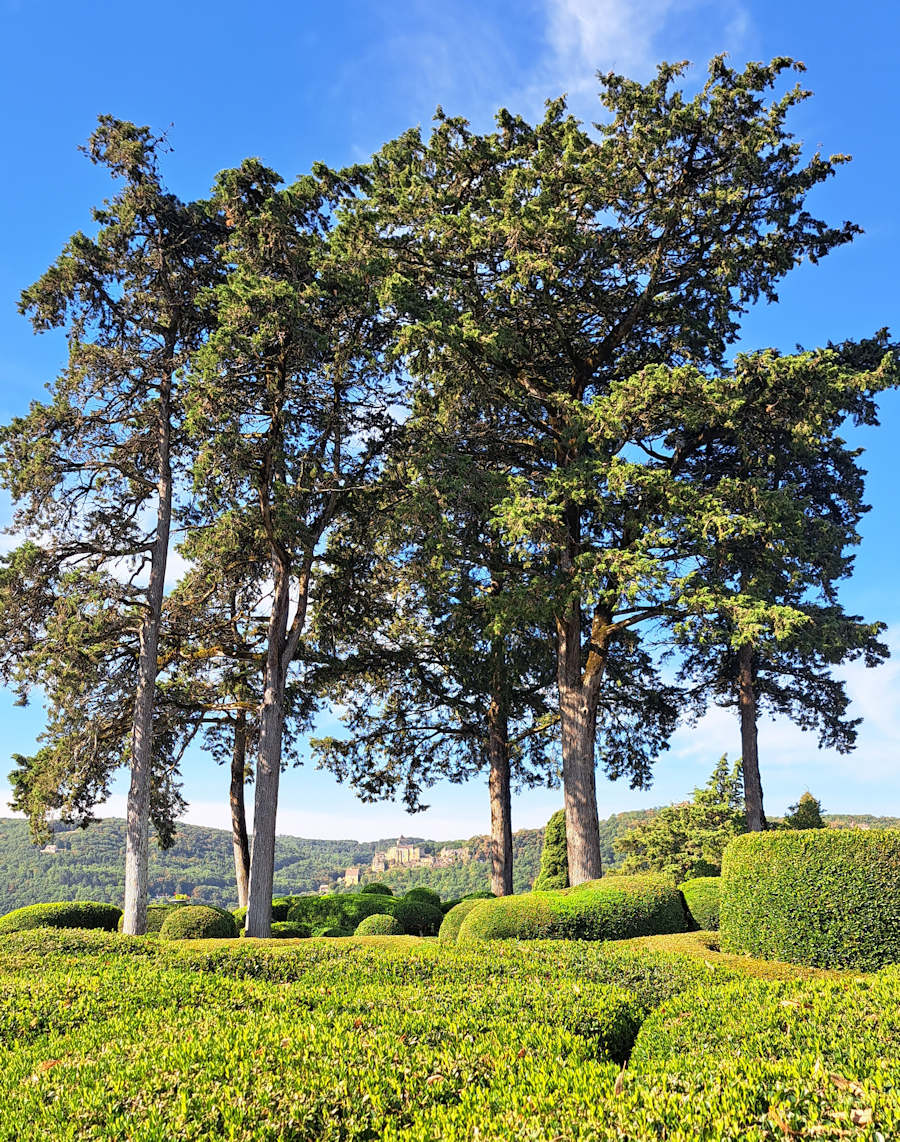
At age 30, Rossillon took the reins of Castelnaud, which he developed into a major tourist attraction with its family-friendly museum about war in the Middle Ages. In 1996, he purchased the estate of Marqueyssac and set about a major restoration of de Cerval’s garden along with contemporary additions that now fit seamlessly into the overall gardenscape. The gardens reopened to the public in 1997.
On the strength of those experiences in Dordogne, Kleber Rossillon’s company has expanded to become a significant private player in the management of historical sites open to the public in France, including the Montmartre Museum in Paris, the Castle of Langeais in the Loire Valley, and the Cosquer Cave in Marseille, among others. His daughter Geneviève Rossillon is now the company’s managing director.
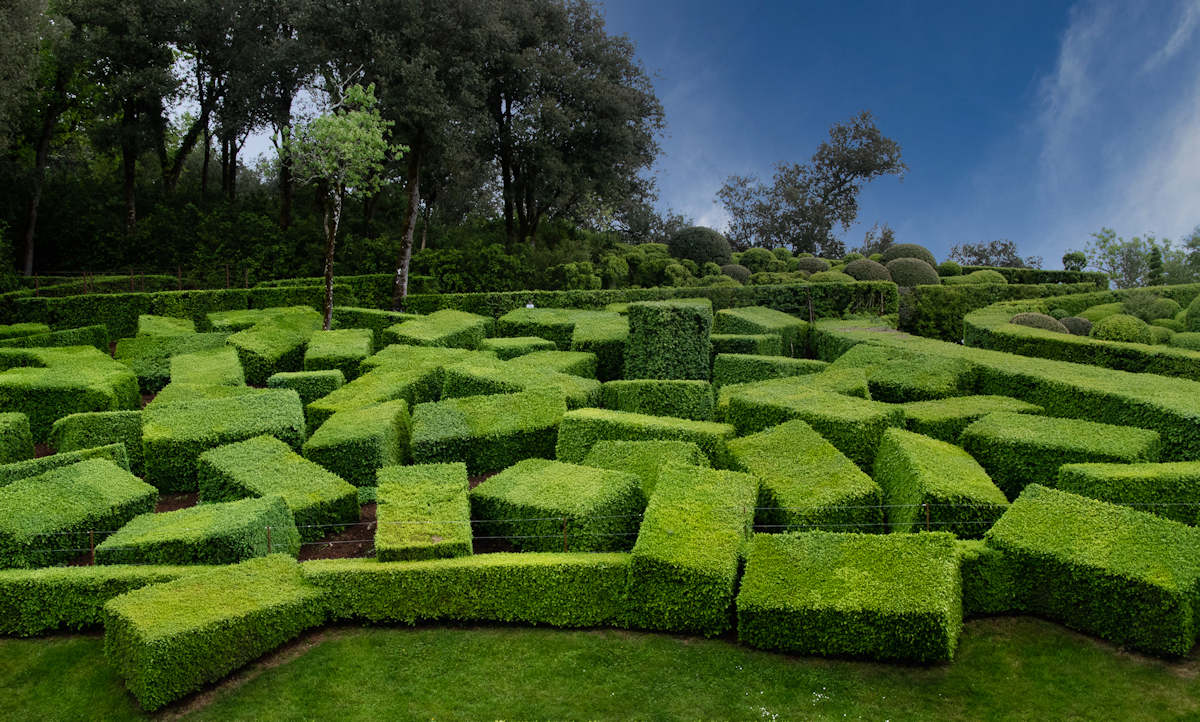
These boxwood topiary “bricks” appear as blocks rolling down the hill towards the château. Plumb lines ensure precision of the rectangular shapes, but the main tools are sharp shears and elbow grease. Not all of Marqueyssac’s boxwoods are topiaries. Many are also left untamed, where they can reach heights of up to 30 feet.
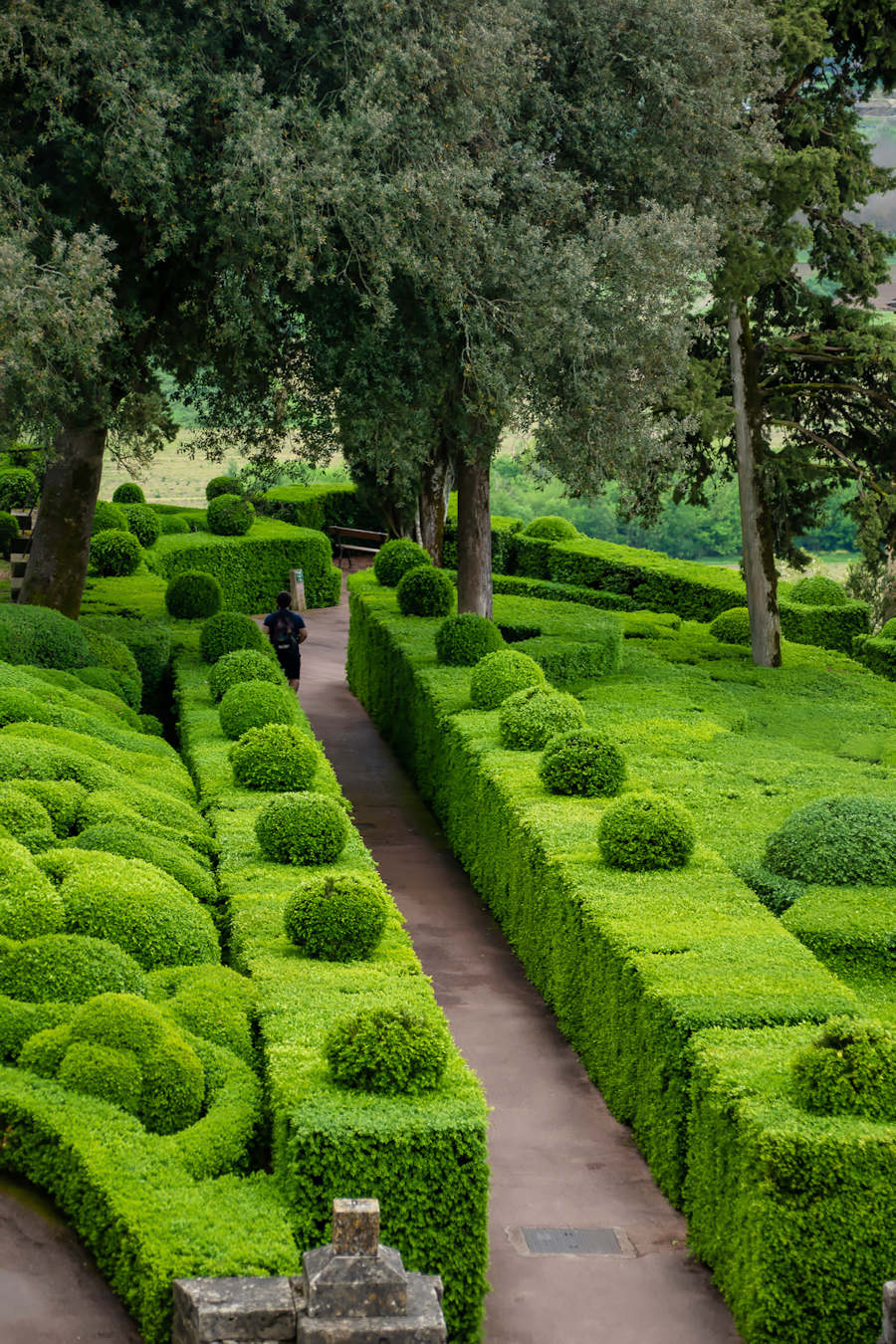
The captivating variety of shades of green catch the photographer’s eye. Keep Marqueyssac in mind if you’re looking for a place to mark World Topiary Day, the Sunday that follows May 12.

If you’ve ever tried your hand at a topiary, you know that creating and maintaining even a single one for just a year requires commitment. Imagine, on your boxwood stroll, the devotion that goes into maintaining thousands of them. Each topiary is hand-trimmed twice per year. When not too crowded, don’t hesitate to use your best French to mention your appreciation to the gardeners for their work and even ask a question or two about it. They may be happy for the opportunity to stretch their aching backs and respond.
Most of the boxwoods at Marqueyssac take their roots from those originally planted towards the end of the 19th-century by then-owner Julien de Cerval.

The Valley-View Stroll
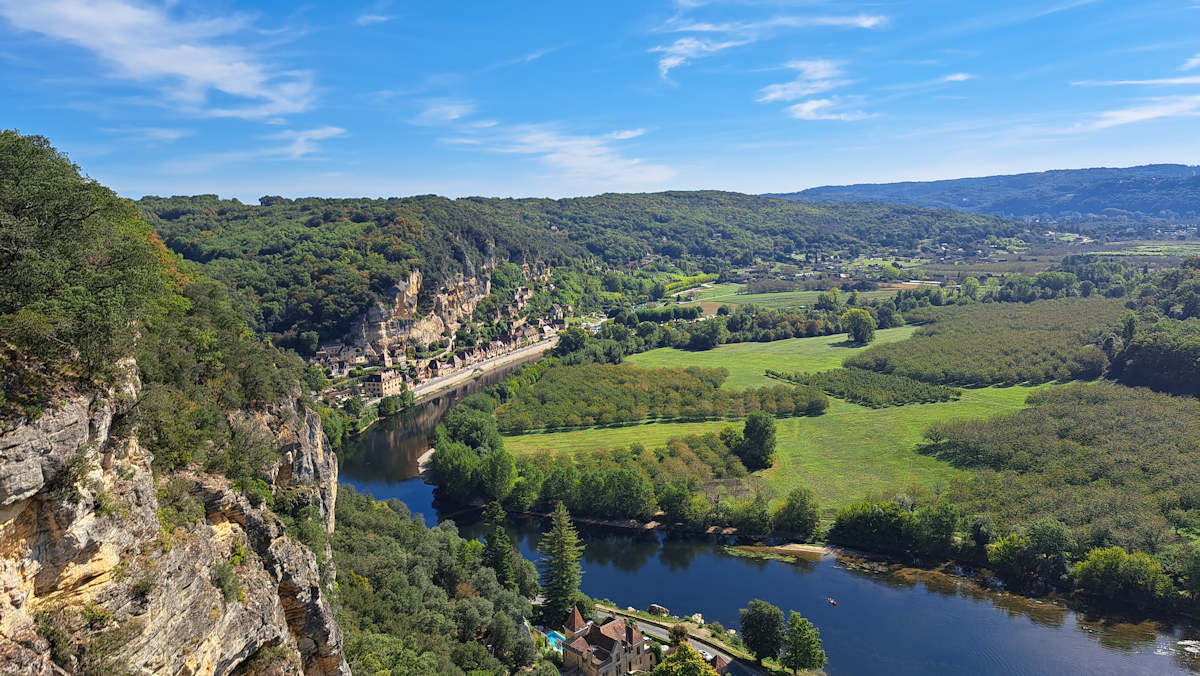
When I compared my photos with Ava’s, I found that hers studiously looked inward and down green pathways in search of the beauty and geometric nuances of the gardens, while mine occasionally turned outward to the Dordogne Valley. Perhaps, in the case of this photo, because I’d just pointed out to my strolling companion that I would next be headed there, to the riverside village of La Roque-Gageac.
I’m a point-and-shoot kind of guy, hoping to come away a telling or memorable image. And I can’t resist a gentle point-and-sweep, though I’m never sure where the sweep should end and sometimes just go around in a full circle. But in the short video below, a garden fairy suddenly appeared indicating that it was time to hit “stop” and stroll on. She’s Stéphanie Angleys, Marqueyssac’s communications officer and my guide through the gardens.
I’d more or less completed our project when Ava returned on a December morning then sent several more photos, including this.
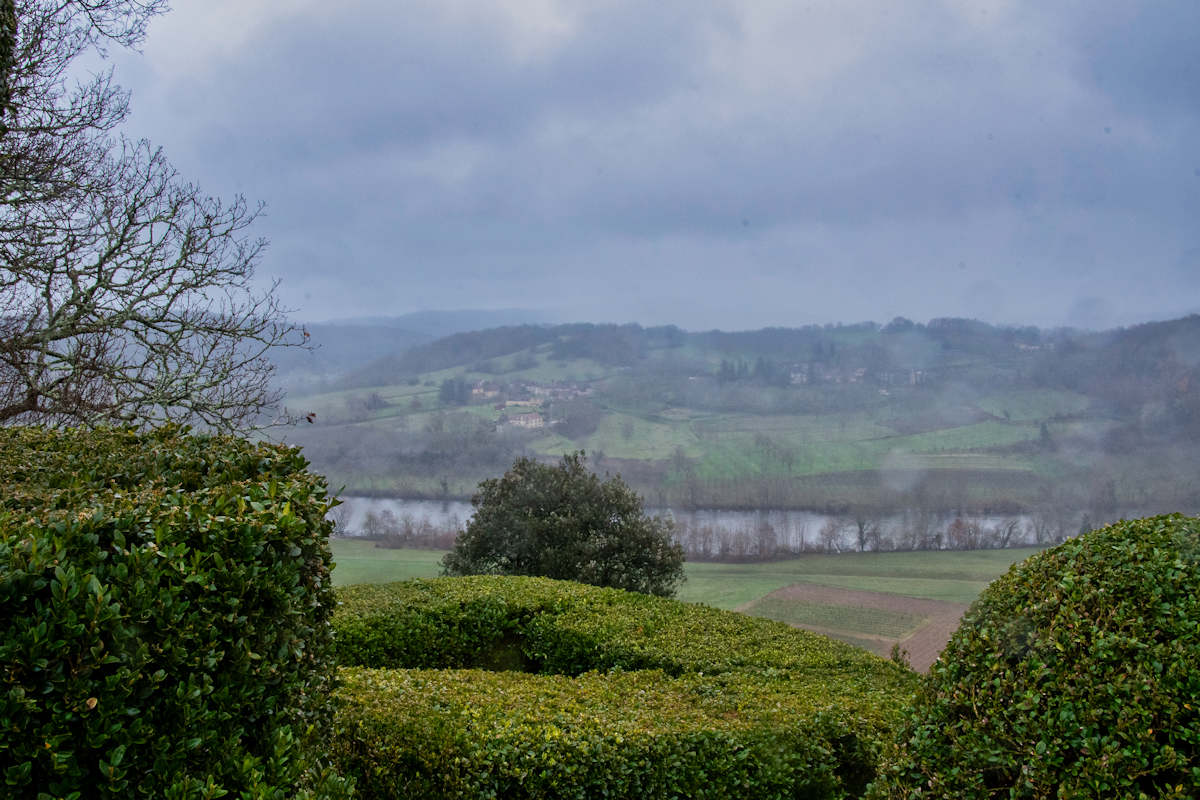
Perhaps it was the dampness of the day that turned her eye away from the garden path, beyond the geometry of the boxwoods and the leaflessness trees to the sodden winter landscape with the grey river running through. Still, you notice that her focus remained in the garden, unwilling to let go and reaffirming that the gardens of Marqueyssac are a year-round destination.
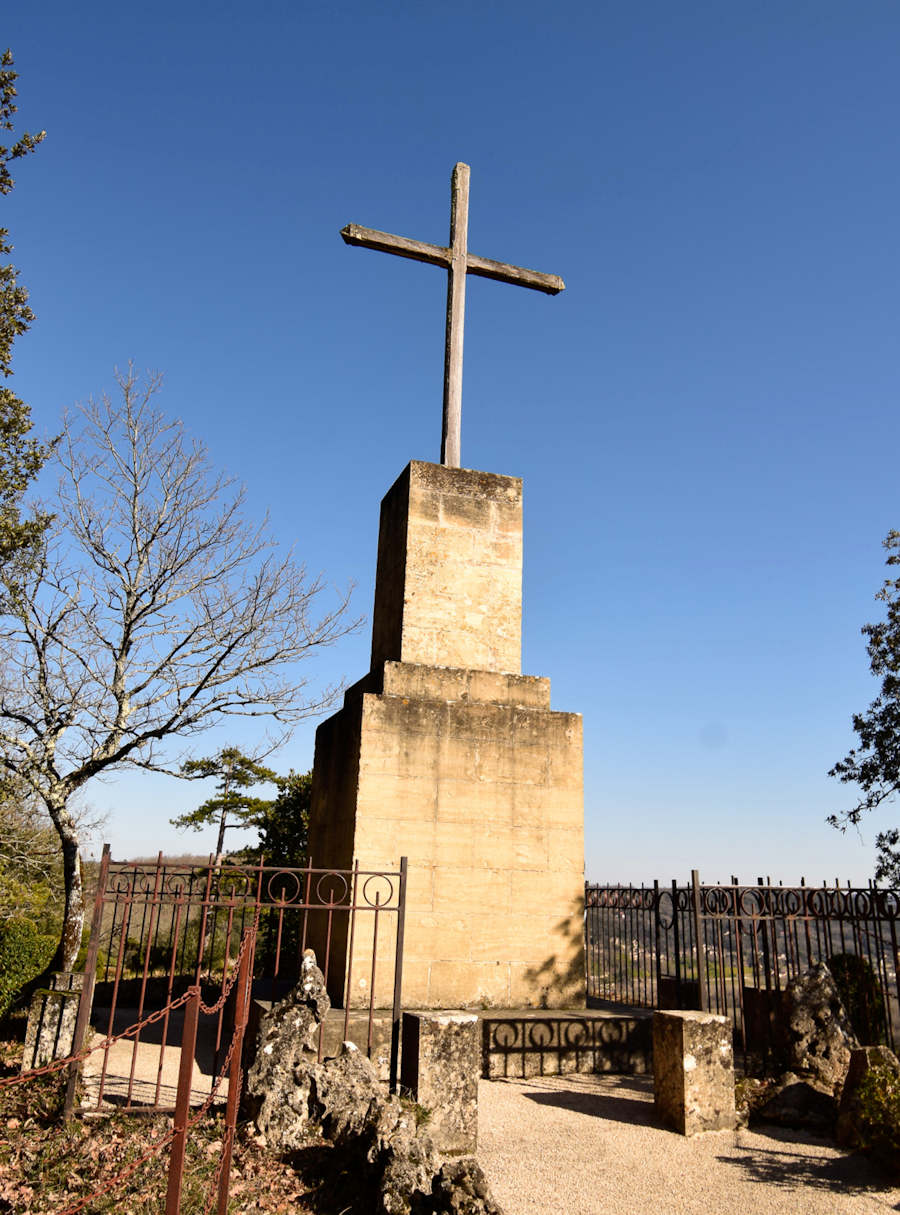
The valley-view stroller—in fact any stroller who makes it to the far end—is rewarded with a 360° view from the highest part of the gardens. This Cross marks the spot. We leave it to you to discover on your own the view that goes with it.
The Romantic Stroll

While you and your loved one will quickly be drawn into the meticulousness of the topiaries, romance thrives on the less planned as well. Beyond the precise trimming, Marqueyssac is home to enough unfocused fantasy—albeit intentionally unfocused fantasy—and dreamy points of view to allow for an exquisite romantic stroll as well.
Arrive early enough in the day and you might even feel that you have the place to yourselves.

The romantic stroll proceeds at a gentle pace. And a stroll wouldn’t be romantic if it didn’t also include a romantic sit, or several, to prolong the pleasure. The bench above, overlooking the valley, is perfectly suited for a starry-eyed conversation (oh, the places we’ve been)… while the one below is an even sweeter spot for a sun-dappled snuggle stop.
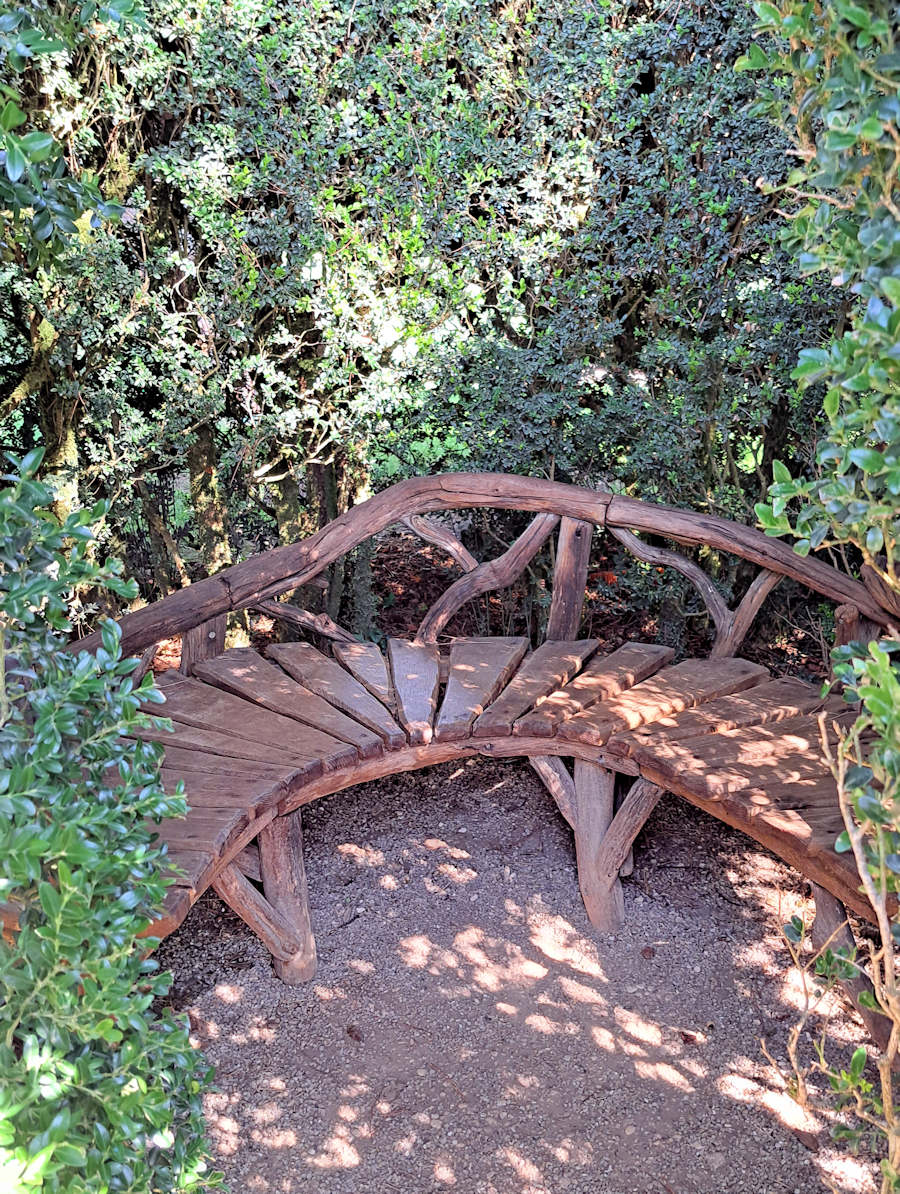
If, after a while, you get into one of those tiffs that even the best of travelers find themselves in with a loved one, turning a corner to find a peacock, the mascot of Marqueyssac, perched on a ledge will be a sign to return to each other’s hand.
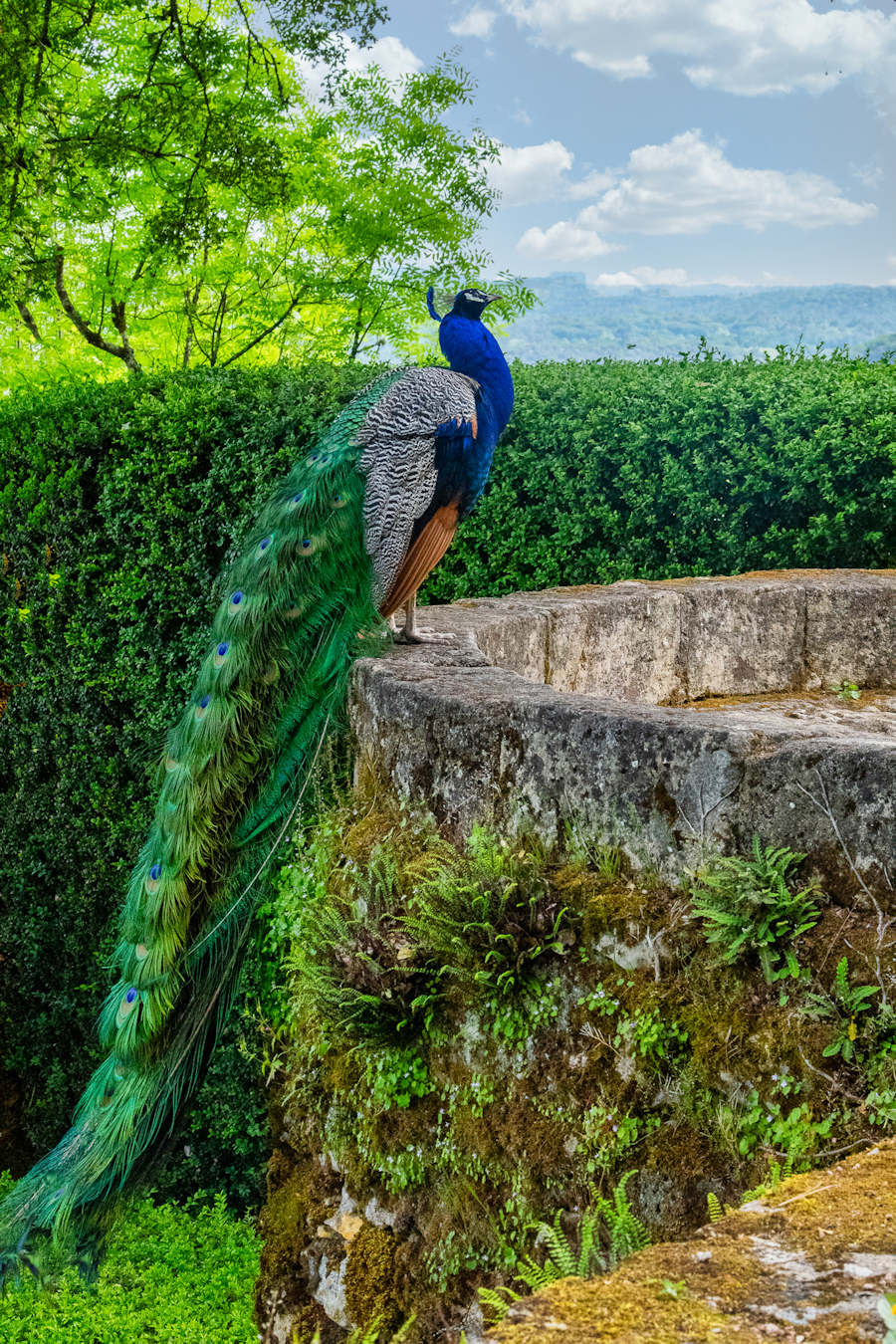
The fellow below isn’t shy about unfurling his seductive plumage in a mating ritual despite human presence—and presumably because there’s a peahen around—so you needn’t either. Within limits of course, and with less of a squawk if possible.
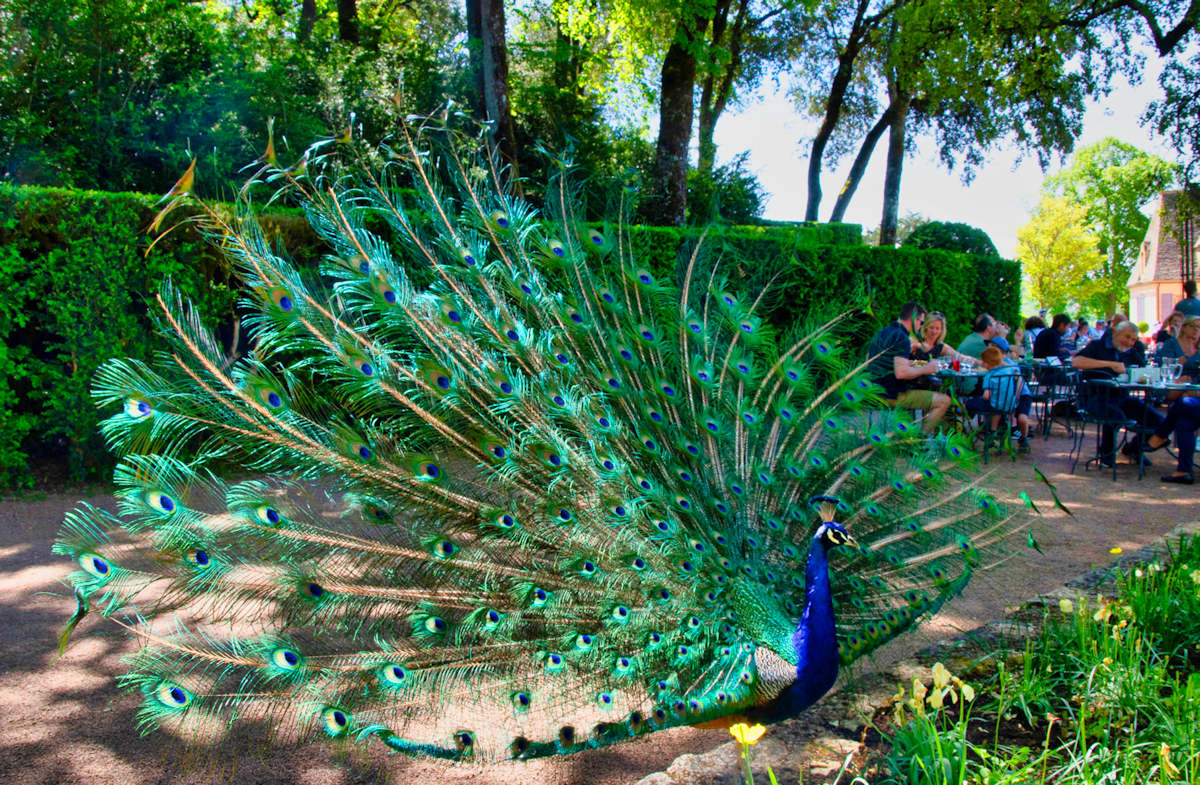
Peering through the evergreen oaks to the village of La Roque Gageac may feel like your private discovery, something that only you and your love share.

If your love was reading a travel guide in bed last night, then he may take this opportunity to inform you that Dordogne, the “department” or sub-region, in which Marqueyssac is located, more or less follows the borders of the historic province of Périgord. So while Périgord no longer officially exists, he’ll explain, the two names are often used interchangeably. Périgord (Dordogne) is unofficially divided into four color-coded landscape-defined sections: Green Périgord, White Périgord, Purple Périgord, Black Périgord. White refers to the limestone soil and the white buildings constructed with it in and around Dordogne’s capital Perigueux. Green refers to the vegetation to the north. Purple refers to the wine growing region in the west (Bergerac and surroundings). Black refers to the dark leaves and shadows of evergreen oaks (quercus ilex) to this southwest quadrant of Dordogne/Périgord. That’s where Marqueyssac lies. Black Périgord is the quadrant with the most tourist appeal (Sarlat, the Dordogne and Vézère Valleys, Marqueyssac, Castelnaud, etc.). That’s fascinating, honey, you’ll reply. Let’s not read in bed tonight.
The Contemplative Stroll
Come alone, walk with a thought-provoking friend, or temporarily lose your loved ones or friends along the way and those same romantic paths and views appear refreshingly contemplative. That snuggle bench above then becomes a seat for private reverie or to write a vignette … as long as you resist taking out your phone to check for messages and news.
Though visitors inevitably remember, photograph and return to the rounded or straight-edge topiaries, the overall park has a rich vegetation that lends itself to contemplation of this good and suffering Earth.
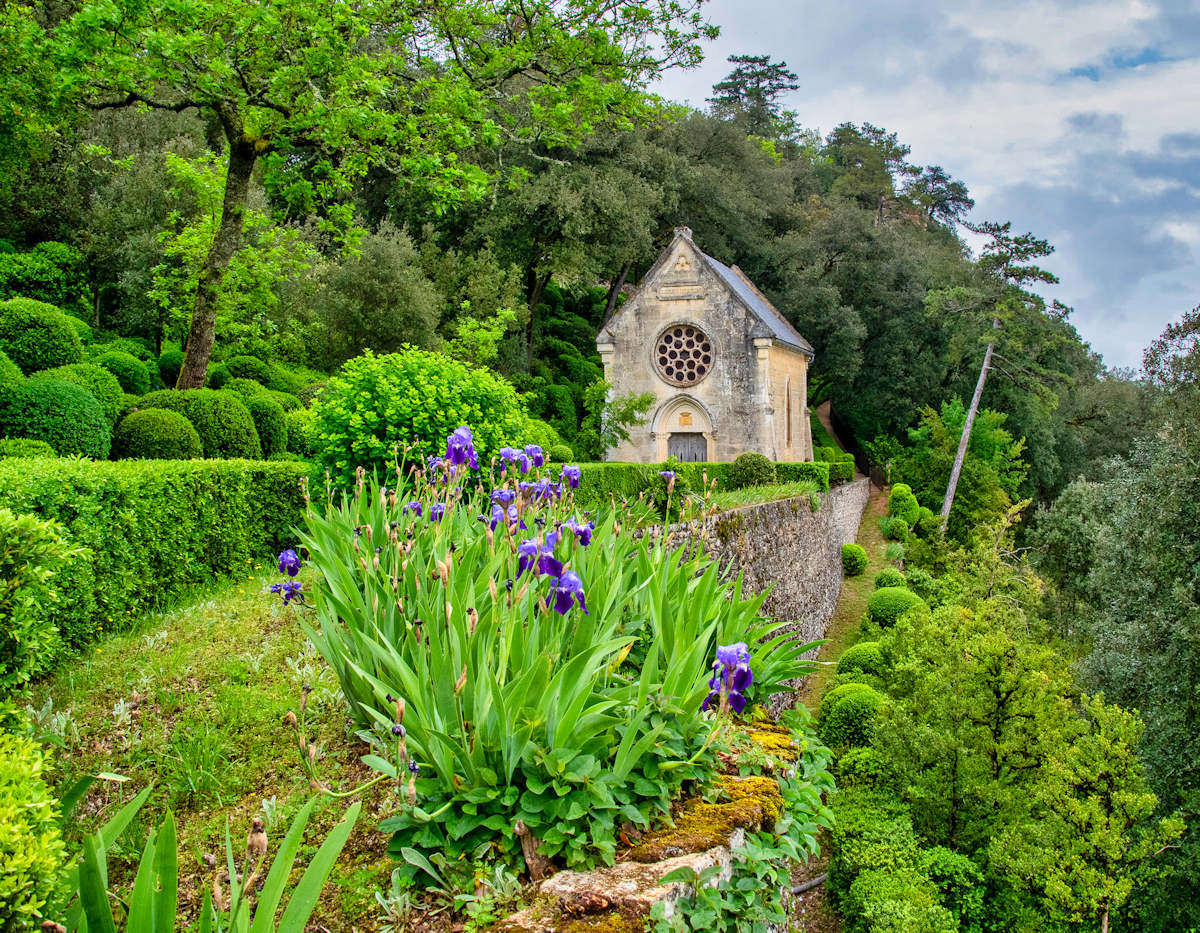
The vegetation on the southern side leans to the Mediterranean with cypresses, umbrella pines, evergreen oaks, and more. Its northern side leans more to the Atlantic with locust trees added to the mix.
Through Ava’s damp lens, the scene by the entrance, which looked so promising in the opening shot, now holds an eerie, contemplative fascination in the photo below.
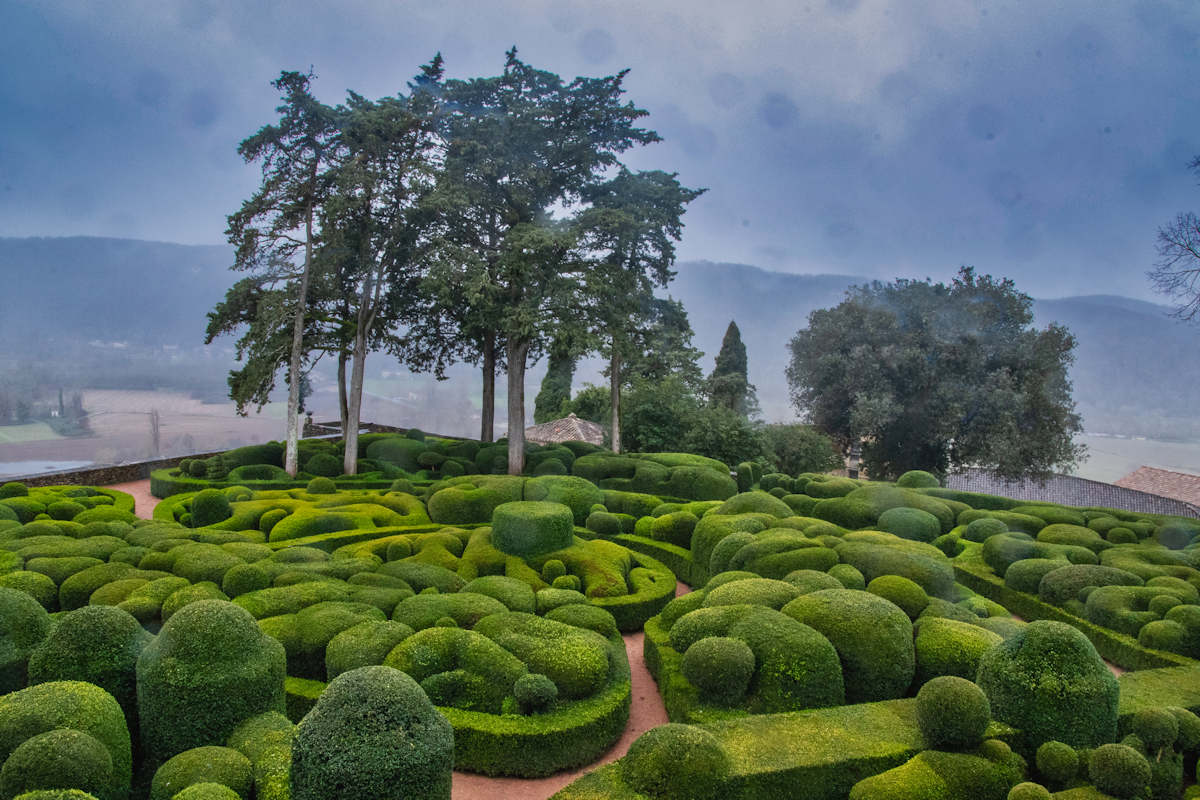
The topiaries no longer appear as the achievement of creative landscapers and hard-laboring gardeners but seem to be caused by something boiling or furrowing underground. Are we safer here or in the disorderly landscape that lies beyond and below. Are the tile rooftops hints of refuge or danger?
Ava found a wistful contemplative moment from inside the chateau, between the parted curtains, looking out to the topiaries and the naked trees on a visitor-less late winter’s morning.
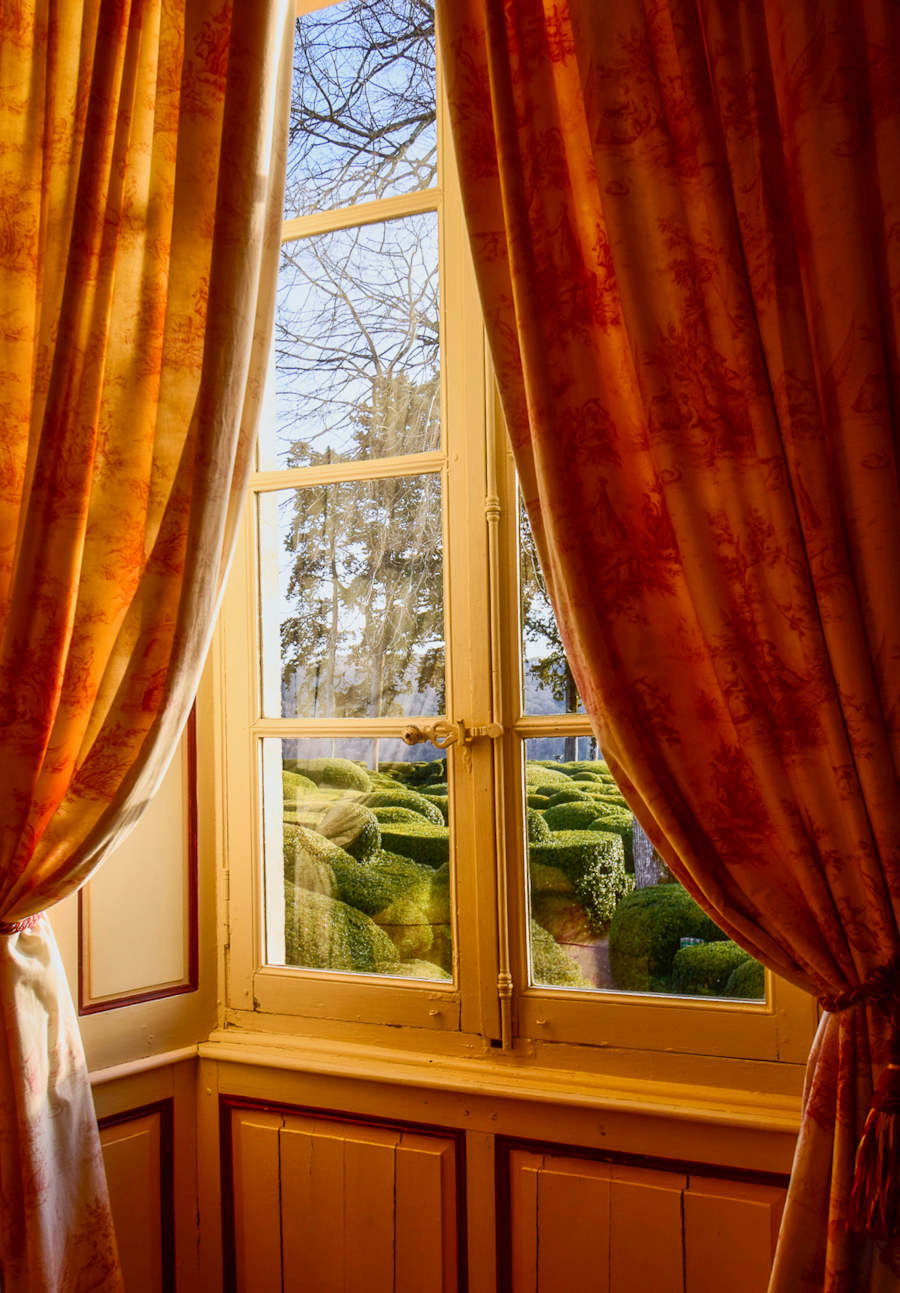
And she found it again with a feeling of quiet and peace beneath the dripping cascade in a shallow pond known as “the Zen.”
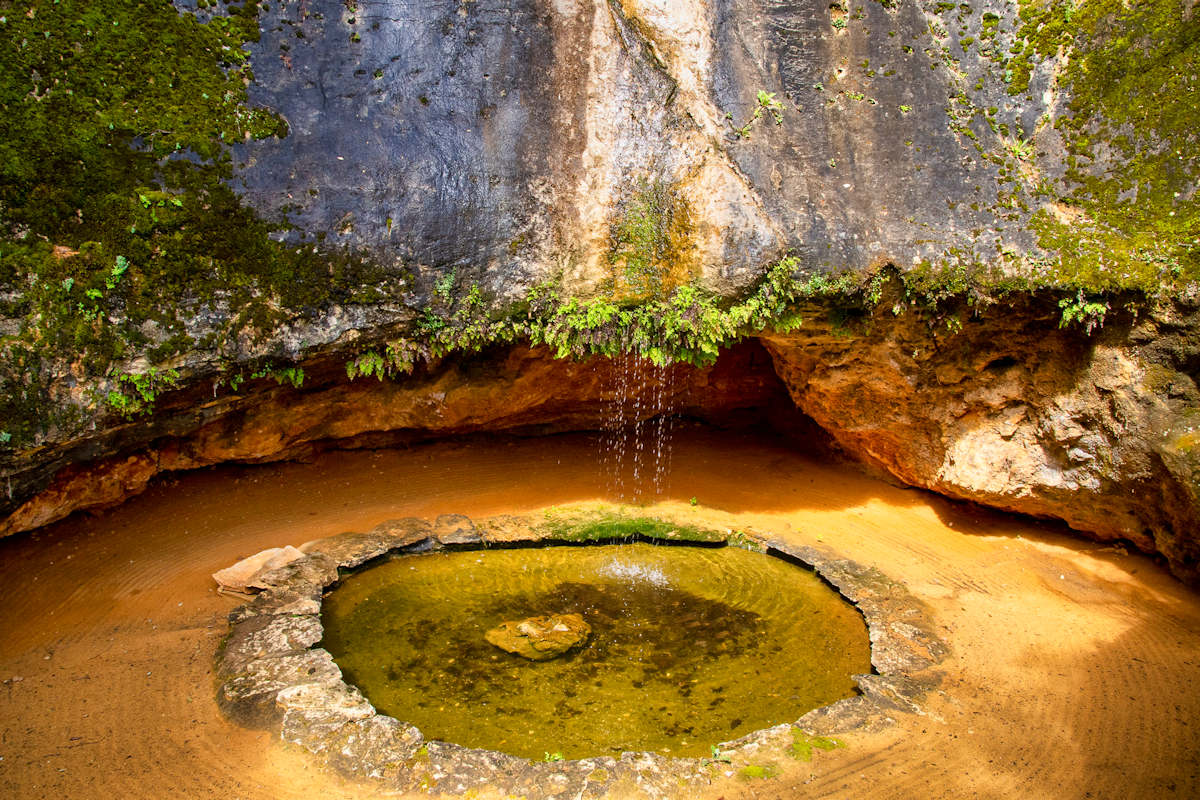
The limestone cliffs that surround Marqueyssac don’t contain any water source other than rain, and there is no spring within the gardens, so Kléber Rossillon added a silent pump to create the waterfall on a closed circuit. But no need to focus on the mechanics in that dreamy corner of the park.
Contemplation may not best describe one’s reaction to the creature below, but if nothing else, the sight of this 150-million-year-old skeleton of an allosaurus, visible from a garden path, will get you wondering what the heck it’s doing here.
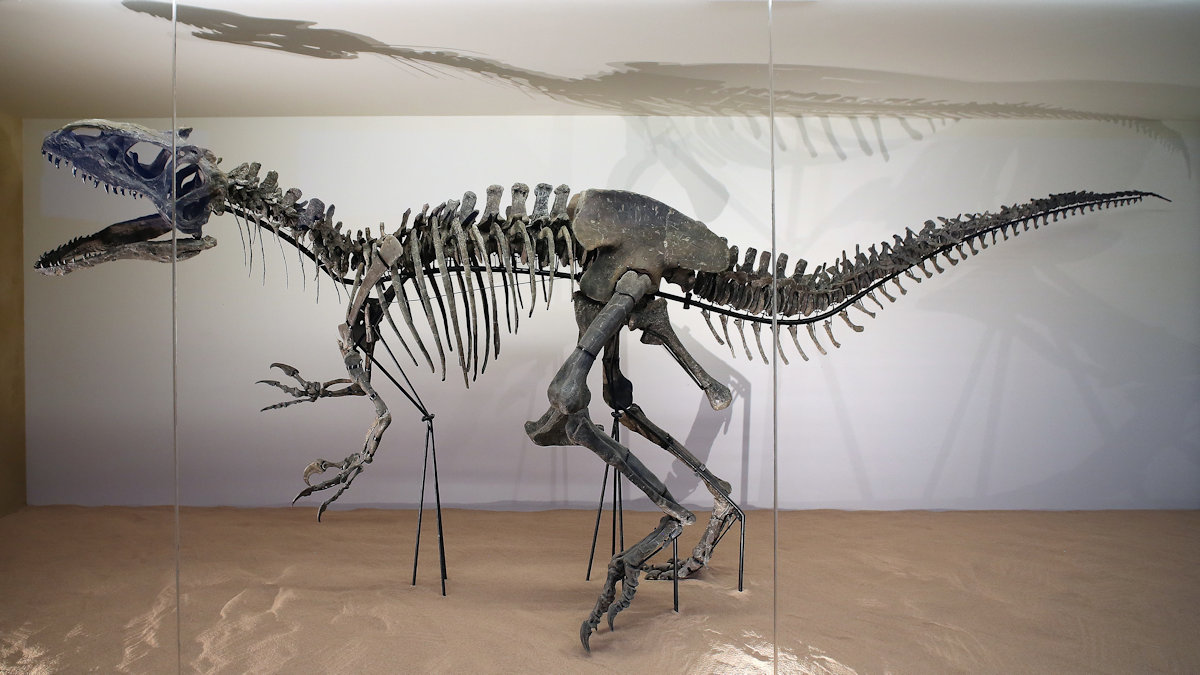
This Jurassic-era dinosaur—about 75% original remnant, measuring 24.6 feet long by 8.2 feet high—was found in Wyoming and purchased by Kléber Rossillon in 2016.
The Cliffhanger’s Stroll
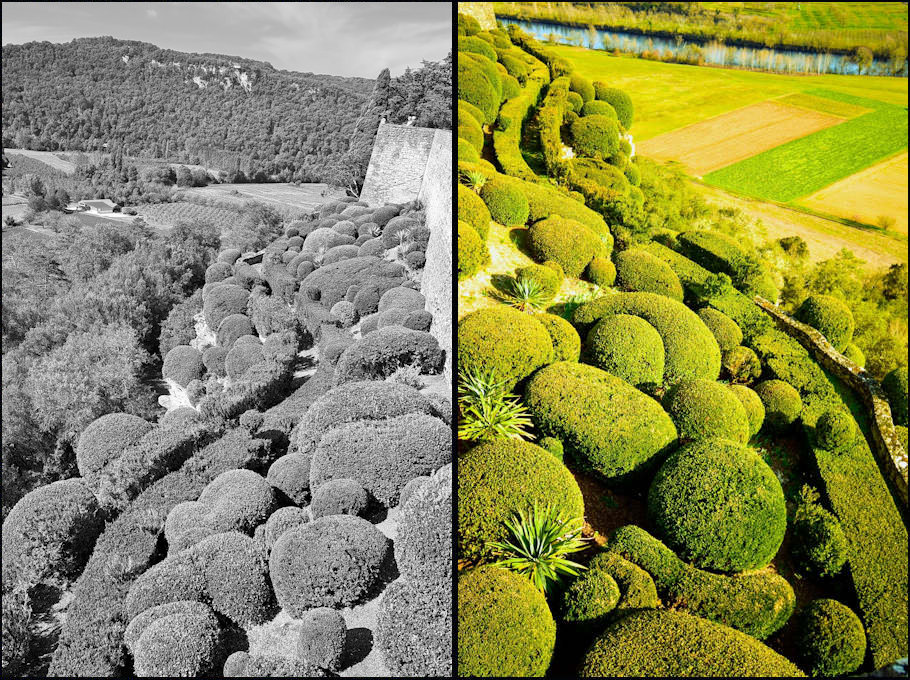
Not only do the gardeners and the boxwoods cling to the cliffs, but so can visitors on a climb-stroll above the greenery along the limestone walls of Marqueyssac.

The cliffside strollway, its Via Ferrata, is punctuated with metal steps and rings and fixed safety cables. Fitted with a harness, lanyard and helmet and attached to the course-long lifeline, visitors 8 years old and over and taller than 1.3 meters (a tad over 4-foot 3 inches) can securely take this 220-yard climb-stroll.
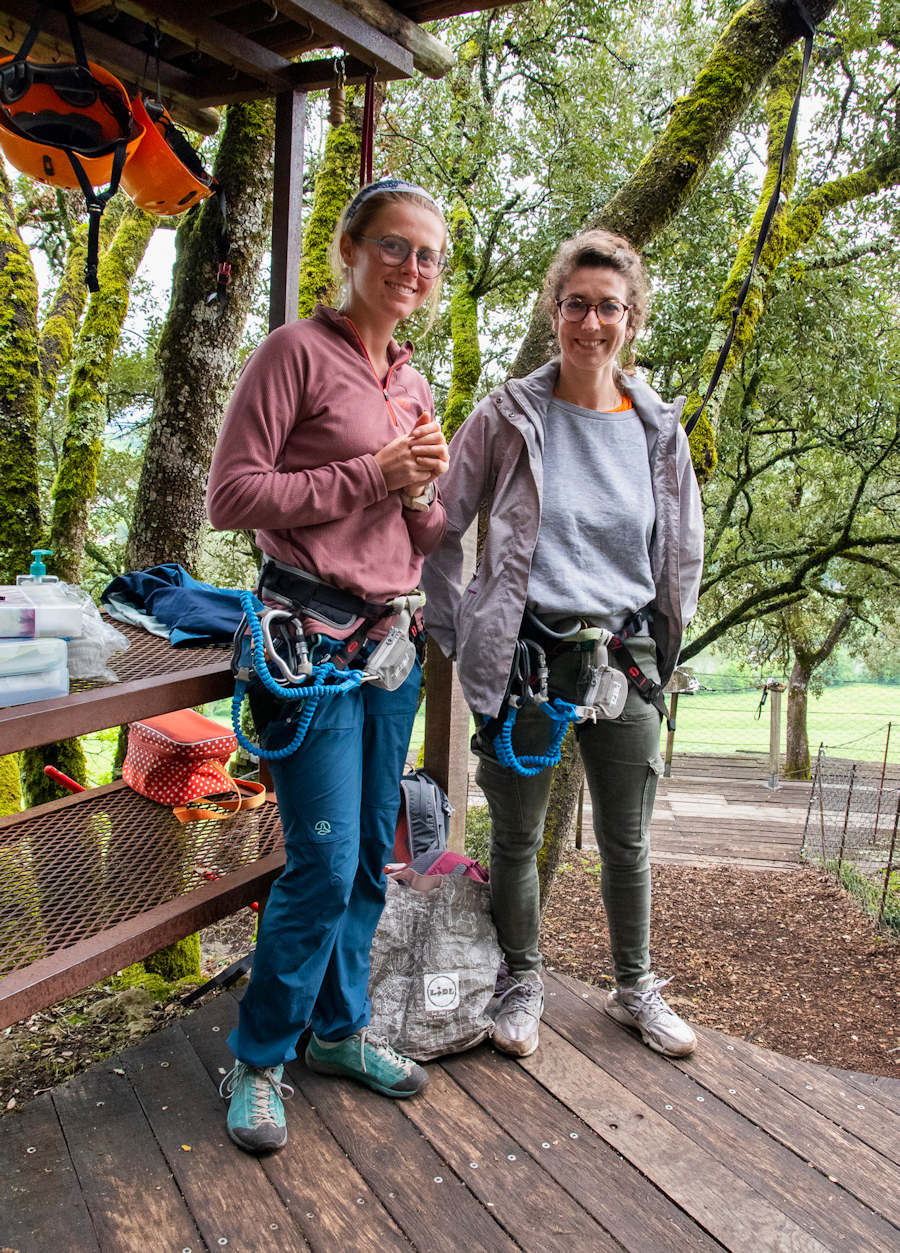
Ava came across this adventurous family as they prepared for final instruction before going on the Via Ferrata.
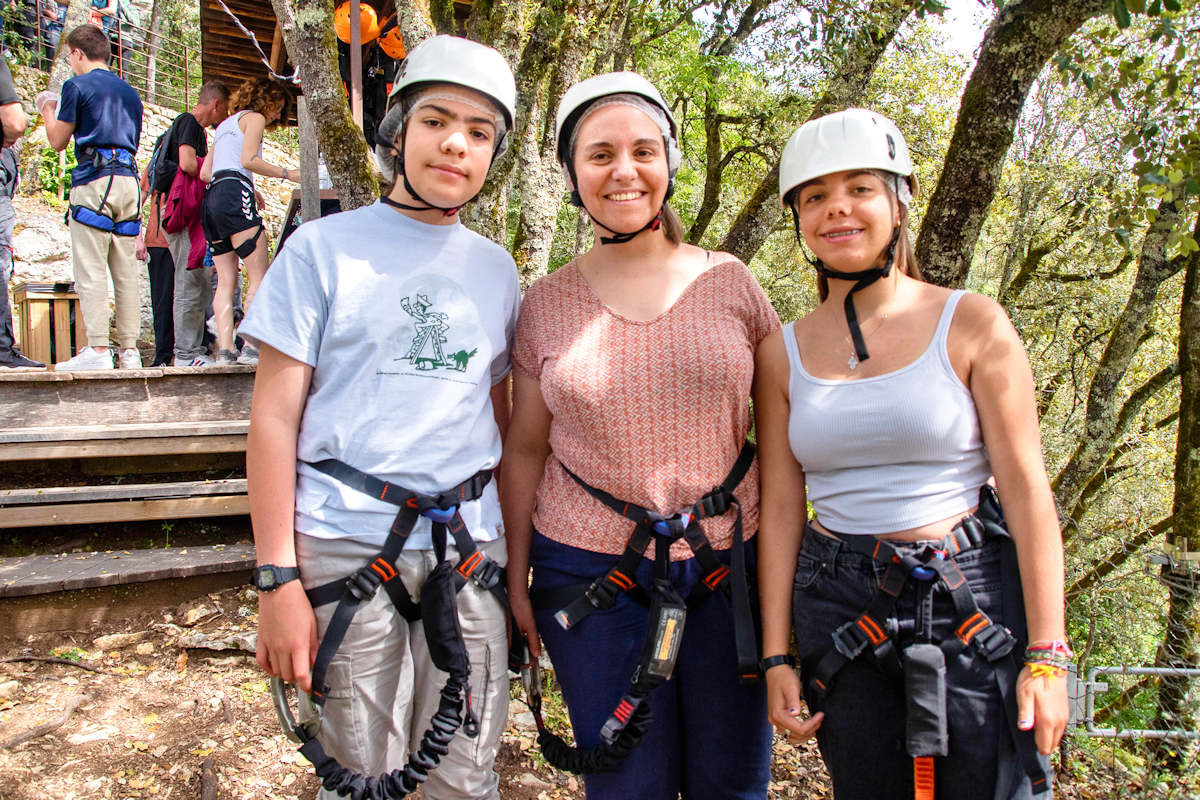
Cliff-strolling not your thing? You can nevertheless step into the trees on this elevated path beyond the creepy rock-head sculptures facing up from the ground.
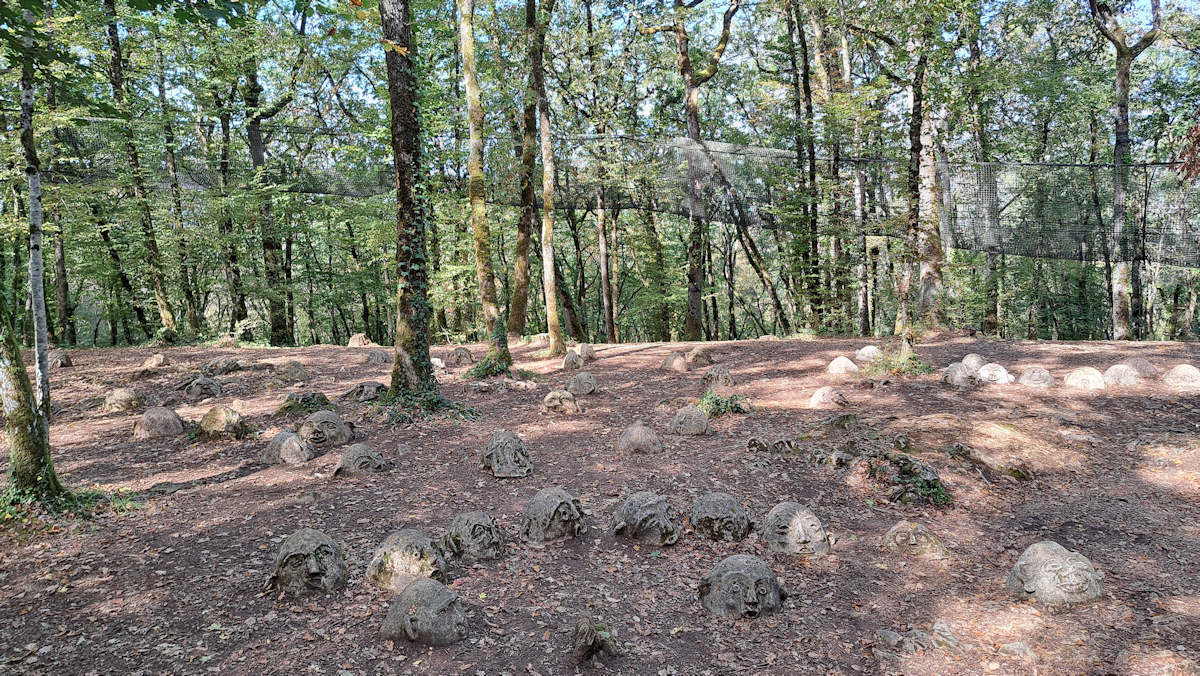
The Family and/or Activities Stroll
Making the most of Marqueyssac doesn’t require joining on a planned tour or activity, especially for romantic or contemplative strollers, but for a family stroll or simply to punctuate your visit, check out the calendar of activities in advance. If interested in the cliff-stroll above, you should time your visit according. There are also nature workshops, a wood turner, yoga classes, and a playground for sliding and climbing.
You might begin with a guided explanation about the garden before venturing off on your own.

“Curious about nature” arts and crafts workshops, particularly aimed at children, are held spring to fall.
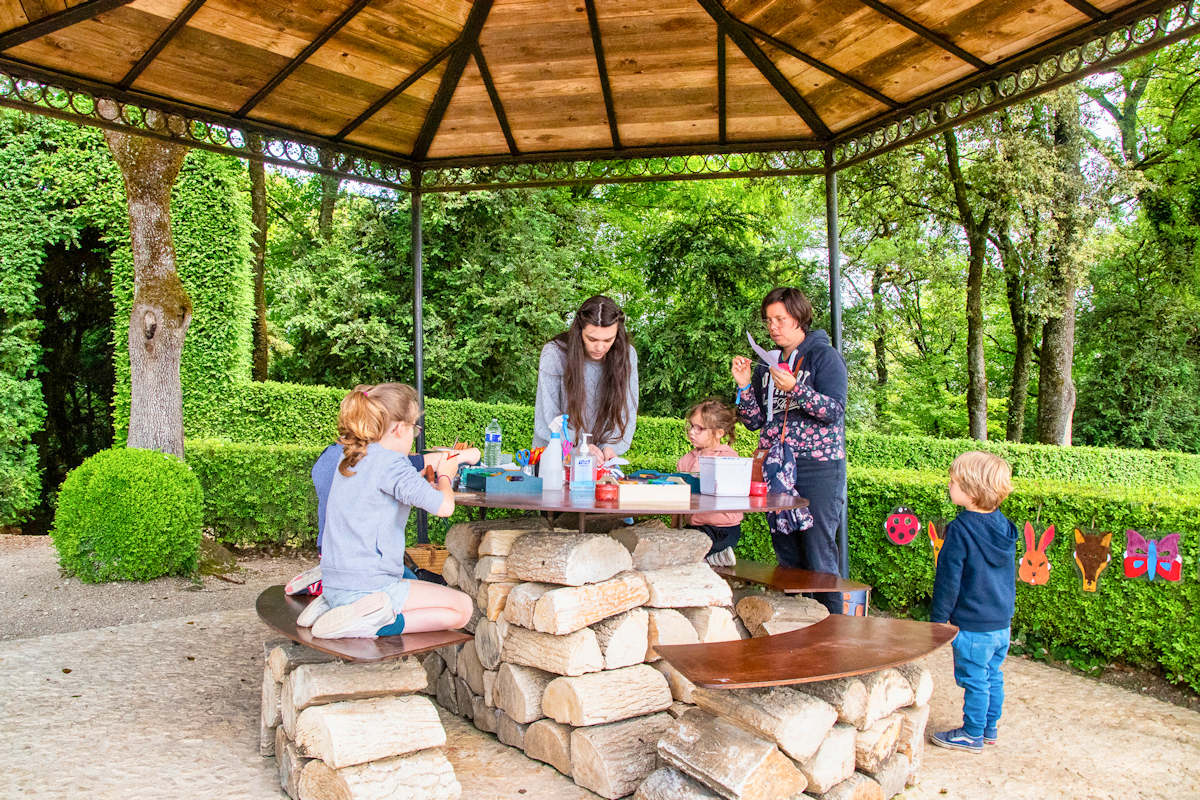

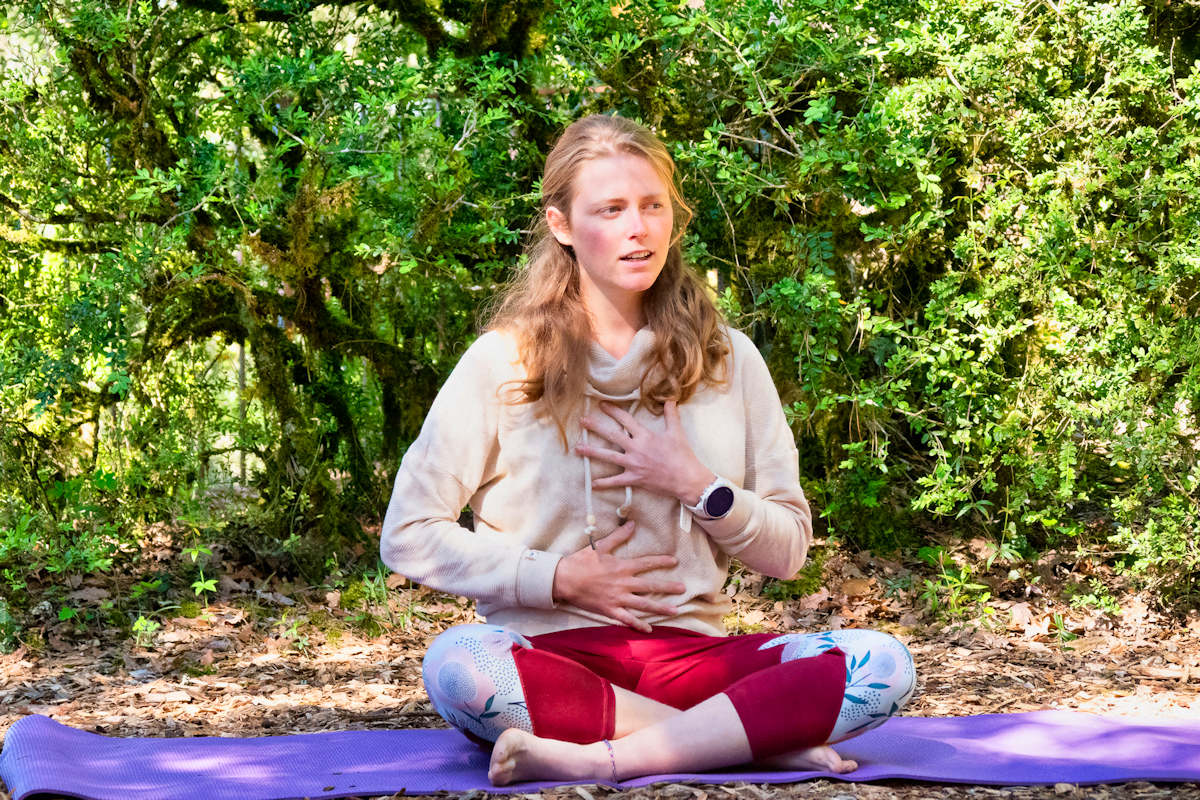


The Chateau Stroll
Though the gardens are the primary interest of Marqueyssac, a visit ends with a brief stroll through the chateau, a late-19th-century residence. A vast restoration of the chateau was completed in 2017. Though called a château, the main residence of the estate appears more as a manor house compared with the massive stone medieval and Renaissance chateaux (Castelnaud, Beynac, Les Milandes, etc.) that can be visited in the region. What’s most impressive about the chateau is its stone-tiled roof. Placed without mortar, the hand-cut limestone slabs (lauzes) have a combined weight of over 500 tons.
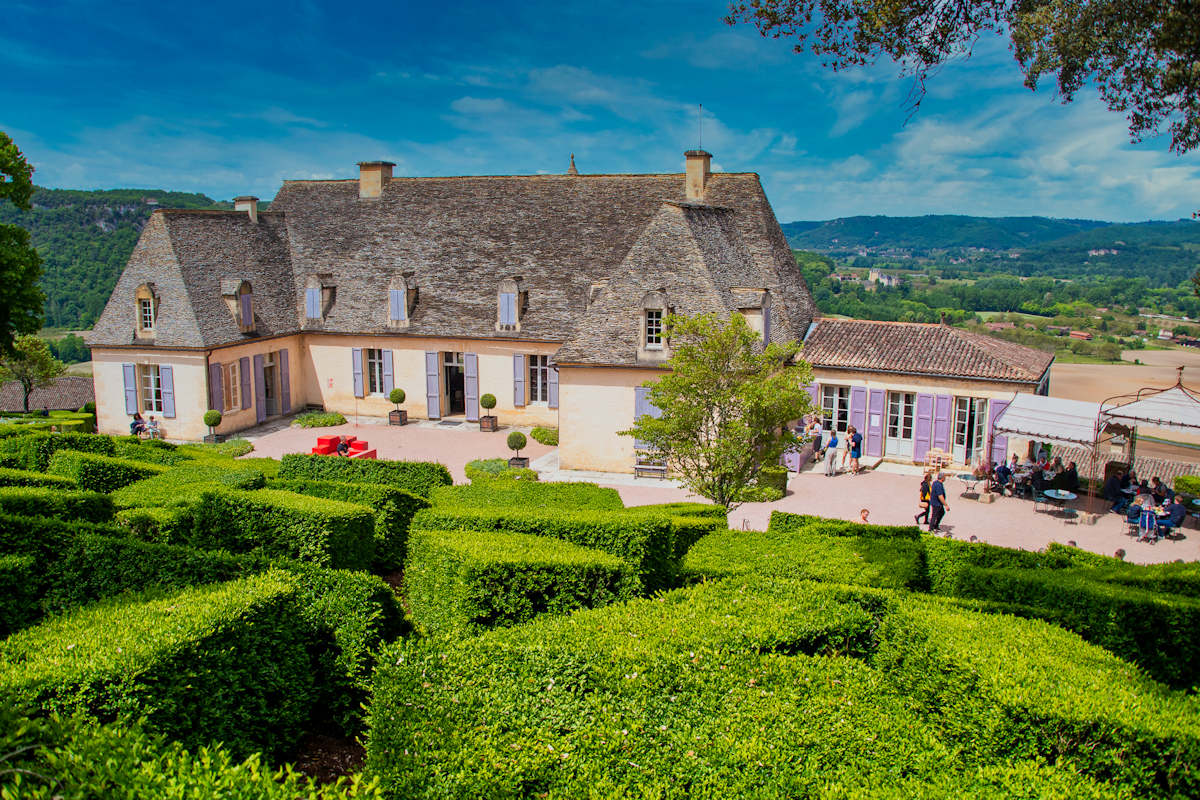
Several rooms can be visited inside.
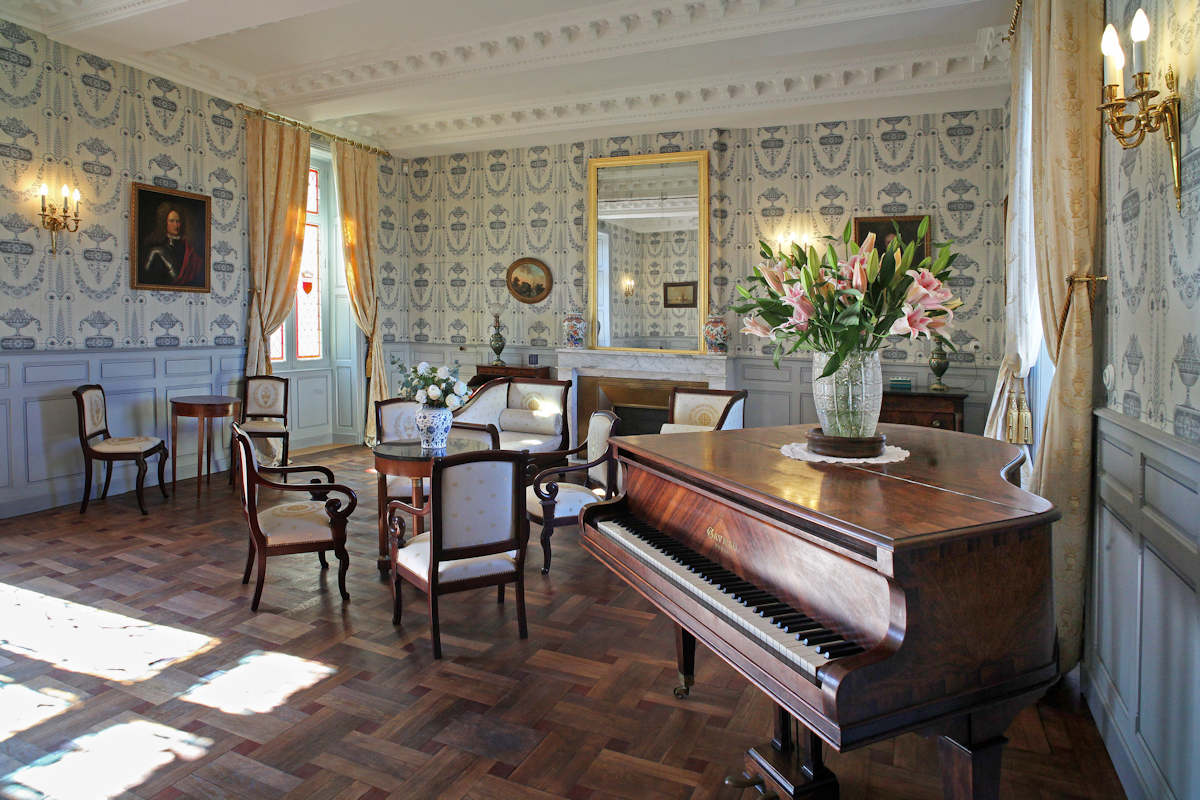

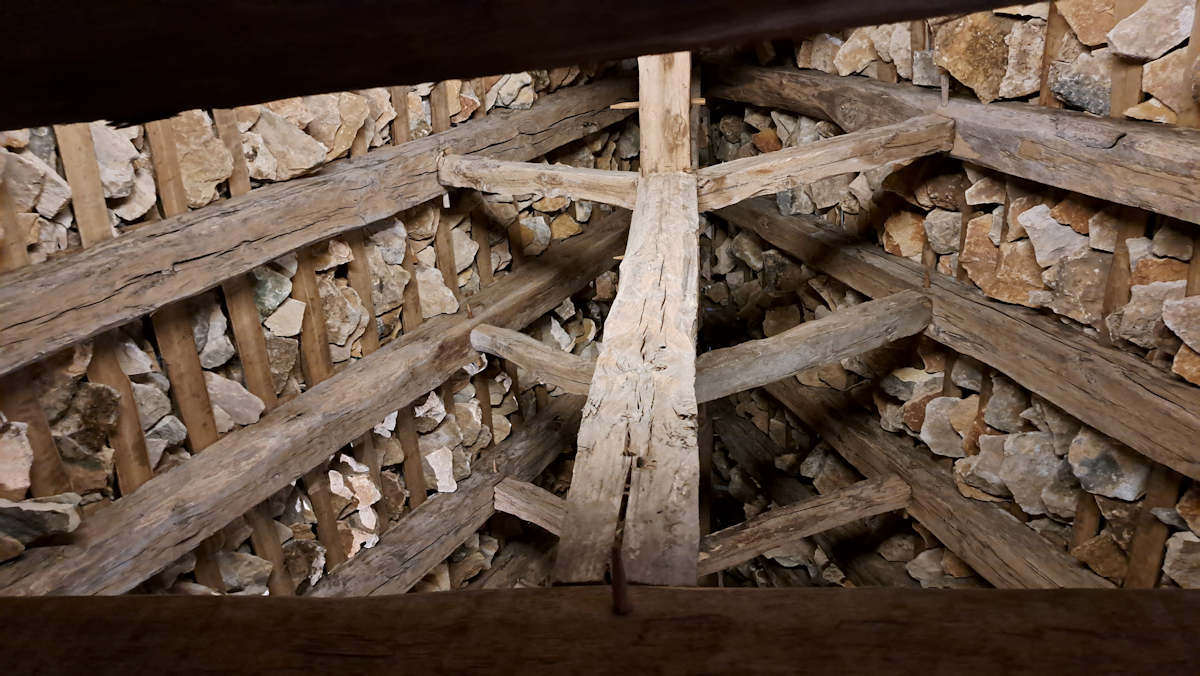
The Candlelit Stroll
Thursday evenings in July and August, Marqueyssac’s Soirées aux Chandelles give the opportunity for visitors to take a candlelit stroll as the day recedes and sunset, twilight then night envelop the Dordogne Valley. The garden paths are lit by 2000 candles and hundreds of other elements of soft lighting, a pianist plays in one corner, there’s a brass quartet in another, perhaps an acoustic guitarist somewhere, and the occasional fairy winging by. The estate is open from 7PM to midnight on those special evenings, but if you don’t plan on spending more than two hours, then arrive at 8/8:30 in order to best experience a leisurely and enchantment stroll through sunset and twilight.
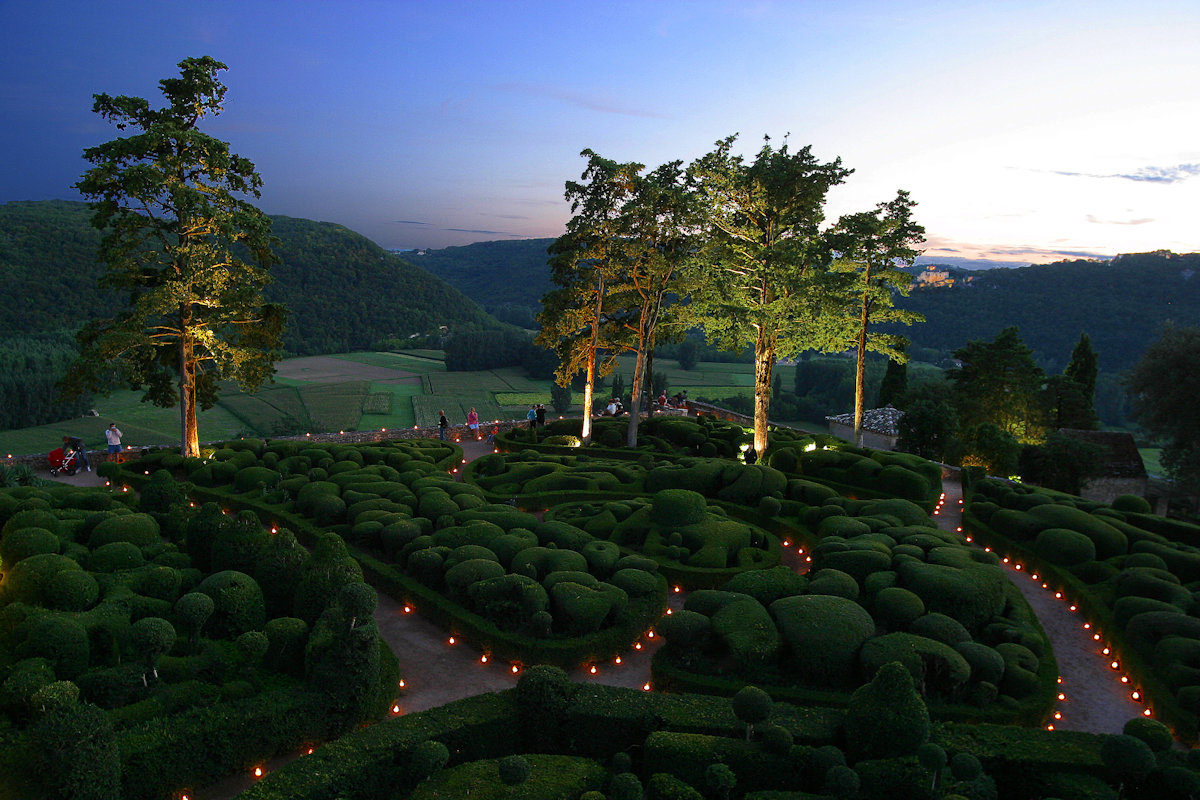
So what’ll it be, daytime or evening, romantic or contemplative or botanical? Will you find yourself more drawn to staring out across the valley or peering down a dimly lit alley? It’s up to you. Marqueyssac offers the opportunity for you to create your own remarkable stroll.
Marqueyssac, 24200 Vezac, Dordogne. See here for seasonal opening times and admission prices and here for the calendar of activities and events. Online reservation is required to attend a Candlelit Evening.
Photos, where indicated, © 2023 by Ava Kabouchy, first published on France Revisited.
Other photos, where indicated, video, and all text © 2023 by Gary Lee Kraut.
Additional photos, where indicated, © Laugery-Les Jardins de Marqueyssac-Dordogne.


17 Jan 2024
Very informative and entertaining.
Beautiful photos!
Now it is time to visit the site myself.